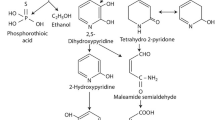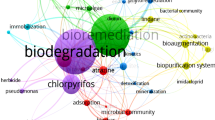Abstract
The s-triazine herbicide terbuthylazine (TERB) has been used as the main substitute of atrazine in many EU countries for more than 10 years. However, the ecological consequences of this substitution are still not fully understood. Since the fate of triazine herbicides is primarily dependent on microbial degradation, in this paper, we investigated the ability of a mixed bacterial culture, M3-T, originating from s-triazine-contaminated soil, to degrade TERB in liquid culture and soil microcosms. The M3-T culture grown in mineral medium with TERB as the N source and citrate as the C source degraded 50 mg L−1 of TERB within 3 days of incubation. The culture was capable of degrading TERB as the sole C and N source, though at slower degradation kinetics. A thorough LC-MS analysis of the biodegradation media showed the formation of hydroxyterbuthylazine (TERB-OH) and N-t-butylammelide (TBA) as major metabolites, and desethylterbuthylazine (DET), hydroxydesethylterbuthylazine (DET-OH) and cyanuric acid (CA) as minor metabolites in the TERB degradation pathway. TBA was identified as a bottleneck in the catabolic pathway leading to its transient accumulation in culture media. The supplementation of glucose as the exogenous C source had no effect on TBA degradation, whereas citrate inhibited its disappearance. The addition of M3-T to sterile soil artificially contaminated with TERB at 3 mg kg−1 of soil resulted in an accelerated TERB degradation with t 1/2 value being about 40 times shorter than that achieved by the native microbial community. Catabolic versatility of M3-T culture makes it a promising seed culture for accelerating biotransformation processes in s-triazine-contaminated environment.






Similar content being viewed by others
References
Bottoni P, Grenni P, Lucentini L, Caracciolo AB (2013) Terbuthylazine and other triazines in Italian water resources. Microchem J 107:136–142
Caracciolo AB, Giuliano G, Grenni P, Cremisini C, Ciccoli R, Ubaldi C (2005) Effect of urea on degradation of terbuthylazine in soil. Environ Toxicol Chem 24(5):1035–1040
Caracciolo AB, Fajardo C, Grenni P, Sacca ML, Amalfitano S, Ciccoli R, Martin M, Gibello A (2010) The role of a groundwater bacterial community in the degradation of the herbicide terbuthylazine. FEMS Microbiol Ecol 71(1):127–136
Di Corcia A, Caracciolo AB, Crescenzi C, Giuliano G, Murtas S, Samperi R (1999) Subcritical water extraction followed by liquid chromatography mass spectrometry for determining terbuthylazine and its metabolites in aged and incubated soils. Environ Sci Technol 33(18):3271–3277
Diels O (1899) Zur kenntniss der cyanurverbindungen. Chem Ber 32:691–702
Dousset S, Mouvet C, Schiavon M (1997) Degradation of [14C]terbuthylazine and [14C]atrazine in laboratory soil microcosms. Pestic Sci 49(1):9–16
EFSA (2011) Conclusion on the peer review of the pesticide risk assessment of the active substance terbuthylazine. EFSA J 9:1–133
Grenni P, Gibello A, Caracciolo AB, Fajardo C, Nande M, Vargas R, Sacca ML, Martinez-Inigo MJ, Ciccoli R, Martin M (2009) A new fluorescent oligonucleotide probe for in situ detection of s-triazine-degrading Rhodococcus wratislaviensis in contaminated groundwater and soil samples. Water Res 43(12):2999–3008
Grenni P, Rodriguez-Cruz MS, Herrero-Hernandez E, Marin-Benito JM, Sanchez-Martin MJ, Caracciolo AB (2012) Effects of wood amendments on the degradation of terbuthylazine and on soil microbial community activity in a clay loam soil. Water Air Soil Pollut 223(8):5401–5412
Guzzella L, DePaolis A, Bartone C, Pozzoni F, Giuliano G (1996) Migration of pesticide residues from agricultural soil to groundwater. Int J Environ Anal Chem 65(1–4):261–275
Guzzella L, Rullo S, Pozzoni F, Giuliano G (2003) Studies on mobility and degradation pathways of terbuthylazine using lysimeters on a field scale. J Environ Qual 32(3):1089–1098
Guzzella L, Pozzoni F, Giuliano G (2006) Herbicide contamination of surficial groundwater in northern Italy. Environ Pollut 142(2):344–353
Hildebrandt A, Guillamon M, Lacorte S, Tauler R, Barcelo D (2008) Impact of pesticides used in agriculture and vineyards to surface and groundwater quality (North Spain). Water Res 42(13):3315–3326
ISO 11465 (1993) Soil quality—determination of dry matter and water content on a mass basis—gravimetric method
Karanasios EC, Tsiropoulos NG, Karpouzas DG (2013) Quantitative and qualitative differences in the metabolism of pesticides in biobed substrates and soil. Chemosphere 93(1):20–28
Kolic NU, Hrsak D, Kolar AB, Petric I, Stipicevic S, Soulas G, Martin-Laurent F (2007) Combined metabolic activity within an atrazine-mineralizing community enriched from agrochemical factory soil. Int Biodeterior Biodegrad 60(4):299–307
Kristensen GB, Sorensen SR, Aamand J (2001) Mineralization of 2,4-D mecoprop, isoproturon and terbuthylazine in a chalk aquifer. Pest Manag Sci 57(6):531–536
Krutz LJ, Shaner DL, Weaver MA, Webb RMT, Zablotowicz RM, Reddy KN, Huang YB, Thomson SJ (2010) Agronomic and environmental implications of enhanced s-triazine degradation. Pest Manag Sci 66(5):461–481
Langenbach T, Schroll R, Scheunert I (2001) Fate of the herbicide 14C-terbuthylazine in Brazilian soils under various climatic conditions. Chemosphere 45(3):387–398
Mandelbaum RT, Wackett LP, Allan DL (1993) Mineralization of the s-triazine ring of atrazine by stable bacterial mixed cultures. Appl Environ Microbiol 59(6):1695–1701
Mandelbaum RT, Allan DL, Wackett LP (1995) Isolation and characterization of a Pseudomonas sp. that mineralizes the s-triazine herbicide atrazine. Appl Environ Microbiol 61(4):1451–1457
Mandelbaum R, Sadowsky MJ, Wackett L (2008) Microbial degradation of s-triazine herbicides. In: LeBaron H, McFarland J, Burnside O (eds) The triazine herbicides. Elsevier, Amsterdam
Nagy I, Compernolle F, Ghys K, Vanderleyden J, Demot R (1995) A single cytochrome-P-450 system is involved in degradation of the herbicides EPTC (s-ethyl dipropylthiocarbamate) and atrazine by Rhodococcus sp. strain NI86/21. Appl Environ Microbiol 61(5):2056–2060
Sajjaphan K, Heepngoen P, Sadowsky MJ, Boonkerd N (2010) Arthrobacter sp. strain KU001 isolated from a Thai soil degrades atrazine in the presence of inorganic nitrogen sources. J Microbiol Biotechnol 20(3):602–608
Sass JB, Colangelo A (2006) European union bans atrazine, while the United States negotiates continued use. Int J Occup Environ Health 12(3):260–267
Shapir N, Osborne JP, Johnson G, Sadowsky MJ, Wackett LP (2002) Purification, substrate range, and metal center of AtzC: the N-isopropylammelide aminohydrolase involved in bacterial atrazine metabolism. J Bacteriol 184(19):5376–5384
Stipičević S, Fingler S, Zupancic-Kralj L, Drevenkar V (2003) Comparison of gas and high performance liquid chromatography with selective detection for determination of triazine herbicides and their degradation products extracted ultrasonically from soil. J Sep Sci 26:1237--1246
Terzic S, Senta I, Matosic M, Ahel M (2011) Identification of biotransformation products of macrolide and fluoroquinolone antimicrobials in membrane bioreactor treatment by ultrahigh-performance liquid chromatography/quadrupole time-of-flight mass spectrometry. Anal Bioanal Chem 401(1):353–363
Thurston JT, Dudley JR, Kaiser DW, Hechenbleikner I, Schaefer FC, Hansen DH (1951) Cyanuric chloride derivatives. J Am Chem Soc 73:2981–2983
Topp E, Zhu H, Nour SM, Houot S, Lewis M, Cuppels D (2000) Characterization of an atrazine-degrading Pseudaminobacter sp. isolated from Canadian and French agricultural soils. Appl Environ Microbiol 66(7):2773–2782
Udiković Kolić N, Martin-Laurent F, Devers M, Petrić I, Begonja Kolar A, Hršak D (2008) Genetic potential, diversity and activity of an atrazine-degrading community enriched from a herbicide factory effluent. J Appl Microbiol 105(5):1334–1343
Udikovic N, Hrsak D, Mendas G, Filipcic D (2003) Enrichment and characterization of atrazine degrading bacterial communities. Food Technol Biotechnol 41(3):211–217
Udikovic-Kolic N, Devers-Lamrani M, Petric I, Hrsak D, Martin-Laurent F (2011) Evidence for taxonomic and functional drift of an atrazine-degrading culture in response to high atrazine input. Appl Microbiol Biotechnol 90(4):1547–1554
Udikovic-Kolic N, Scott C, Martin-Laurent F (2012) Evolution of atrazine-degrading capabilities in the environment. Appl Microbiol Biotechnol 96(5):1175–1189
Acknowledgments
This study was financially supported by the Croatian Ministry of Science, Education and Sports (Project nos. 098-0982934-2712 and 058-1252086-0589). We thank Prof. Zvonimir Ostojić from the Faculty of Agriculture, University of Zagreb for providing soil from the experimental station in Šašinovečki Lug. We further thank Dr. Neda Vdović from Rudjer Bošković Institute and the staff of the Department of Soil Amelioration and Department of General Agronomy of the Faculty of Agriculture, University of Zagreb, for their cooperation in soil characterization.
Author information
Authors and Affiliations
Corresponding author
Electronic supplementary material
Below is the link to the electronic supplementary material.
ESM 1
(PDF 480 kb)
Rights and permissions
About this article
Cite this article
Jurina, T., Terzić, S., Ahel, M. et al. Catabolism of terbuthylazine by mixed bacterial culture originating from s-triazine-contaminated soil. Appl Microbiol Biotechnol 98, 7223–7232 (2014). https://doi.org/10.1007/s00253-014-5774-8
Received:
Revised:
Accepted:
Published:
Issue Date:
DOI: https://doi.org/10.1007/s00253-014-5774-8




